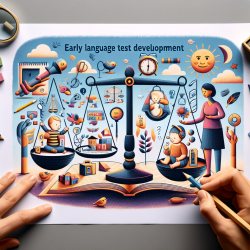The field of autism research is continuously evolving, providing new insights into the biological underpinnings of this complex disorder. One such groundbreaking study is "Atypical Genomic Cortical Patterning in Autism with Poor Early Language Outcome," which sheds light on the genomic differences that may contribute to poor language outcomes in autistic children. This blog post aims to distill the key findings from this research and offer actionable steps for practitioners to enhance their skills and improve therapeutic outcomes.
The Research at a Glance
The study explores how genomic cortical patterning differs between autistic toddlers with good versus poor early language outcomes. The researchers found that while typically developing and autistic toddlers with good language skills exhibit normative anterior-posterior (A-P) and dorsal-ventral (D-V) genomic patterning, this is absent in those with poor language outcomes. Instead, these children show a secondary and independent genomic patterning effect on cortical thickness (CT).
Key Takeaways for Practitioners
- Early Identification: Understanding the genetic markers associated with poor language outcomes can aid in early identification and intervention.
- Tailored Interventions: Recognizing that poor language outcomes may stem from atypical prenatal brain development allows for more targeted therapeutic approaches.
- Focus on Prenatal Development: The study highlights the importance of prenatal development in shaping later language abilities, suggesting that interventions might benefit from focusing on prenatal risk factors.
Implementing Research Findings
As a practitioner, integrating these findings into your practice can significantly impact the effectiveness of your interventions. Here are some strategies to consider:
- Genetic Screening: Collaborate with genetic counselors to incorporate genetic screening as part of the assessment process for children at risk of autism.
- Customized Therapy Plans: Develop individualized therapy plans that consider the unique genomic profile of each child, focusing on enhancing areas impacted by atypical cortical patterning.
- Continued Education: Stay updated with ongoing research through webinars and conferences to continually refine your approach based on the latest scientific discoveries.
Encouraging Further Research
The study opens new avenues for further research into how genomic factors influence autism spectrum disorders. Practitioners are encouraged to engage with ongoing research efforts and contribute to expanding our understanding of autism's genetic components.
To read the original research paper, please follow this link: Atypical genomic cortical patterning in autism with poor early language outcome.










